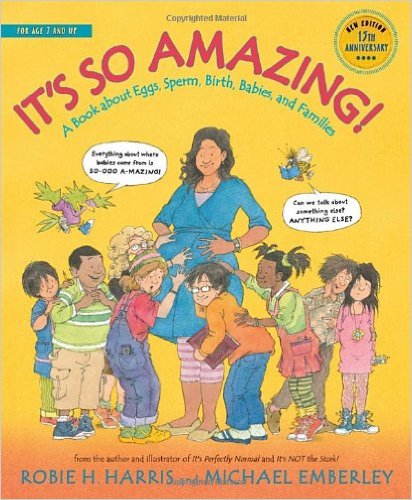Anatomy of Female Bodies
This video goes over the external and internal parts of biological female anatomy. It also defines the vulva, urethra, vagina, and anus, specifying the difference between the vulva and the vagina. The video defines ovaries and briefly explains the internal process of menstruation. [AMZ-070]
Youth
Most people have the same basic body parts—heads, arms, legs and feet. While we are mostly similar, we do have different reproductive and sexual organs. A person who is female or assigned the sex of female at birth typically has these parts that are visible on the outside of the body: the pubic mound, the inner and outer lips (or labia), the clitoris, the urethra, the vaginal opening and the anus.
People with vaginas also have a variety of internal reproductive organs, including ovaries, Fallopian or uterine tubes, a uterus and a vagina. When a person with a vagina goes through puberty, the ovaries begin to release tiny eggs about once a month. When one of the ovaries releases an egg, it travels down the Fallopian or uterine tubes toward the uterus. Each month when there is no pregnancy, the uterus sheds its extra lining and pushes it out through the vagina. This is what is commonly called “getting your period.”
It is important to take care of one’s sexual health by knowing what your body is like when it’s healthy and seeking medical care if anything should change with how your body functions, looks or smells.
FAQs
There are no set changes that happen for everyone. Some girls begin with growth spurts during which they grow taller. For others, the first sign may be that their breasts begin to grow or hair starts to grow under their arms and in their pubic area.
During puberty, girls begin to get their menstrual periods. Menstrual periods are when a small amount of blood and tissue leave the body through the vagina over the course of a few days. It happens about once every month and can last from a couple of days to a week. Some girls have cramps during their periods while others don’t. Girls commonly use a maxi pad, tampon or feminine hygiene cup to manage the blood that leaves their body during a period.
When a girl gets her first period, it signals that her body has begun ovulating. Ovulation happens once a month when a hormone or chemical in the body signals a girl’s ovaries to release an egg or ovum. This means that if a girl has unprotected sex she could become pregnant. The hormone estrogen is also released to signal to the girl’s uterus to build up its lining. If after sex an egg is fertilized by a sperm, the fertilized egg will implant in the lining and cause a pregnancy. If an egg is not fertilized within 12 to 24 hours after ovulation, the egg dies and disintegrates. Two weeks later, when the uterus realizes there is no fertilized egg, the built-up lining of the uterus is released, or shed, during a girl’s menstrual period.
Boys often begin puberty a little later than girls. Below are some common changes boys go through during puberty:
- Growing hair on the face, under the arms and in the genital area
- Growing taller
- Broadening shoulders
- Deepening voice
- Having frequent and at times spontaneous erections
Possibly experiencing wet dreams, meaning ejaculating semen while sleeping. (This is normal if it happens and normal if it does not.)
Additional Resources
Parents
Most young people go through the many physical, emotional and social changes of puberty between the ages of 9 and 15. If caring adults use the appropriate anatomical names for children’s body parts, this lays the foundation for talking about the changes of puberty before and while young people are experiencing them. It is also essential to assure young people that these changes are normal. Helping young people identify ways to cope with these changes can make this stage of life less stressful. Talking about these changes with the young people in your life lets them know that they are not alone and that they can come to their parents or guardians if they have questions or need support.
CONVERSATION STARTERS
When she mentions a friend you know, you can say, “Wow, Amber has really developed this year.” You can then use this time to talk about how different people go through puberty at different ages.
When you get home and unpack the groceries, tell your daughter that you bought these for her. Explain that you know that she hasn’t gotten her period yet and that it may still be awhile, but you want her to know that these things are here for her when she needs them. You can go on to talk more about how to use them and/or tell her you are always there for her, whenever she wants to talk more about these things.
Educators
Most young people go through the many physical, emotional and social changes of puberty between the ages of 9 and 15. During this time, it is important for health educators to use the appropriate anatomical names for body parts and educate students about how the body functions. This lays the foundation for lessons that require knowledge of anatomy. Explaining the changes of puberty to young people before and while they are going through them will help reassure them that these changes are normal. Helping young people identify ways to cope with these changes can make this stage of life less stressful. Talking about these changes with the young people lets them know that they are not alone and that they can come to their parents, guardians or other trusted adults if they have questions or need support.
National Sex Education Standards
List medically accurate names for body parts, including the genitals
Recall the human reproductive systems, including the external and internal body parts and their functions, and that there are natural variations in human bodies
International Technical Guidance on Sexuality Education
Discussion Questions
What are some of the external body parts that were mentioned in the video?
What is the function of that body part?
What are some of the internal body parts that were mentioned in the video?
What is the function of that body part?
Were there any body parts or names for body parts that were new or surprising to you?
How might using the correct anatomy terms be useful to someone?




